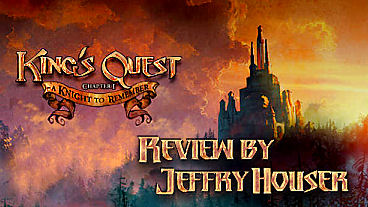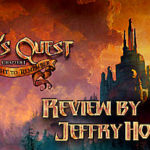
King’s Quest: A Knight to Remember Review
Despite the imperfections, this game is a worthy successor to the King’s Quest name.






Genre: Adventure
Release date: July 21, 2015
I played King’s Quest 1 in 1984 on a PCjr. It came on a single floppy disk and a cartridge. A special overlay could be put on the keyboard so we could easily remember special keys. I don’t remember what the special keys were but if I recall correctly, one would even make Graham swim. The game was the most amazing thing I’d ever seen and I was hooked very quickly. Since then, I’ve played every adventure game I could get my hands on and, time permitting, still do to this day.
King’s Quest is back! Its been a long hiatus since the last official release, and the game world has changed. Roberta Williams, our beloved designer, has long since retired. The Odd Gentleman, a relatively unknown studio, was hired by Activision to create an episodic adventure in the King’s Quest world. Can they take the magic of old and re-create it for today’s world? The Sierra community has been arguing about this for months. The trailers make the game look like a platformer with a focus on action. Some of the marketing text alludes to a focus on Telltale-style stories instead of exploration. Will this game bring influences from the typing genre of adventure games? Will the point-and-click heritage affect gameplay?
Read on for my take.
The new King’s Quest is framed with King Graham telling stories to his granddaughter Gwendolyn. The game opens in mid-story, with Graham retrieving the magic mirror quest from the dragon – originally part of King’s Quest 1. Graham approaches the well, goes inside, and the rest is history. Well, sort of. This isn’t the history I remember from 1984. Rather than retaining the simplicity of one of the first graphic adventures, the segment beneath the well is an expansive cavern system full of levers and booby traps. This serves as the game tutorial and teaches you how to interact with the new game world, and a few creative liberties have been taken.
After retrieving the mirror, we get to watch a cut scene with Gwendolyn. Then Graham’s story switches to his first day in Daventry. Graham is going to participate in a tournament to become a Daventry knight. The bulk of the game deals with the tournament challenges and interactions with the other knight-hopefuls, although there are a few side-quests along the way.
I was not prepared for my first look at Daventry in this game. I remember exploring Daventry in King’s Quest 1 and it was a small castle surrounded by wide open spaces, ponds to swim in, the occasional tree to climb, and a mix of scattered dwellings. I also remember a sense of excitement in King’s Quest 3 as Alexander returned to Daventry. We got to see part of the land we loved from King’s Quest 1 in ruins – familiar but different. In Knight to Remember, the lay of the land has changed and the new Daventry is unrecognizable.
Daventry is now a forest. There’s a sprawling town center instead of scattered dwellings. The only landmarks of the old game that made their way into the land are the dragon well and the castle. The carrot patch becomes a pumpkin patch and its location is moved. These changes don’t detract from the gameplay but are something I noticed. The Silver Lining was a great example of a recreation of a 2D land in 3D, and playing that game felt like coming home. This new Daventry is foreign.
I speculate the change in geography is due to the game engine. In the original King’s Quest you could exit the game screen at any point and you could walk anywhere. In this game, each screen has a defined path for Graham to walk. Barriers are needed to keep you on the path. When you’re in a building, walls are used. When you’re outside, trees are heavily used.
Despite my cognitive dissonance with the geographic layout, the visuals are beautifully crafted. They reminded me of Mind: Path to Thalamus at times. The world was created with water colors and then scanned into the computer. It looks beautiful on my screen. I don’t know what I would expect a King’s Quest to look like today; but this is as good as anything I could imagine.
When I think of Graham, I think of a gallant knight who overcame obstacles to become king. I view King’s Quest as a straight-forward game series about an adventurer using his mind. However, The Odd Gentleman reimagined Graham as Guybrush Threepwood’s older brother. This game is built for comedy and is loaded with puns, over-the-top characters and silly jokes. It seems out-of-place thematically. At times the game felt more like Monkey Island than King’s Quest.
The voice acting is wonderful, with Christopher Lloyd voicing old Graham. Wallace Shawn, most famous as Vizzini in The Princess Bride, voices Manny, one of Graham’s fellow knight-hopefuls. With Wallace Shawn in the cast the game has a lot of Princess Bride references, and the last challenge of the tournament is a game of wits between Manny and Graham, complete with powder potions.
There are three other knight challengers. The first is Acorn, a big strong knight who loves squirrels. Graham must defeat him in a battle of strength. Achaka speaks an unknown language. Graham travels with him while searching for the eye to a ferocious beast. Achaka is the most serious and competent,character in the game. Finally, Whisper is a self-absorbed knight whom Graham must defeat in a duel of speed.
The townsfolk consist of a blacksmith, a baker, and an alchemist couple. Each of the townsfolk parallels one of the paths Graham can choose in his adventure. The Blacksmith represents bravery. The baker represents compassion. The alchemist represents wisdom. Unfortunately, the different paths of the game aren’t very well implemented. There are a few choices you can make, but other than the first tournament challenge, very little of the game changes. I don’t think this is enough to warrant multiple playthroughs unless you’re a die-hard.
The game is a cross between a point-and-click game and a platformer. The game controls don’t make use of a mouse, so you won’t be pointing-and-clicking. However, when Graham approaches an item with which he can interact, an interaction icon pops up. Graham can then interact with the item using the space bar. Or Graham can bring up inventory using the tab key and select an inventory item to use with a game piece. There aren’t a lot of items to interact with in the world, so most puzzles are pretty easy to figure out.
The game also has its share of arcade style mini-games and quick time events. During the intro sequence, for example, Graham rides a mattress down some rapids and the game prompts you to click the arrow keys in order to avoid the dragon, cave rocks, and other obstacles. Another example is when the travelling merchant is attacked by Goblins. Graham fights them with a bow and arrow.
The game makes use of an auto-save feature that works pretty well. However, the game lacks the option to save at specific spots, such as before making a choice, and then restoring to easily see the results of a different choice. If you want to experiment with the results of different game choices, then you’re stuck replaying the whole game. Unfortunately the game doesn’t include a ‘skip cut scene’ or ‘continue to the next line of dialog’ option, so game replays are more extended than they should be.
In most 3D games, you can look up and down and left and right and explore the land. However, that isn’t an option here. In most screens you can only go in two directions, forwards and backwards, and the screen either zooms in or zooms out as you move through the landscape. The exception is a few close-ups without Graham on screen. When you look at a bookshelf in the dragon dungeon or a shelf in the alchemist shop, you’re able to move around to view more of the area. It took me awhile to get used to this. However, this approach does simplify the control scheme from games such as Dreamfall Chapters, where I’m often juggling mouse movement with keyboard controls.
Some of the hype in the pre-game talk was that a lot of interactions had multiple responses filled with lots of Easter eggs, but you just had to keep “clicking” to find them all. Unfortunately, I found very few items with multiple responses that were worth clicking on more than once. Without the ability to skip through dialog or cut scenes, watching short animations play out after every click made the game feel repetitious. I taught myself to avoid double clicking in order to avoid the tediousness. The absence of a way to skip dialog or cut schenes should go on the list of deadly Adventure game sins.
King’s Quest: A Knight to Remember has more gameplay than the recent crop of Telltale stories, but not enough to match an old school Sierra or LucasArts adventure. If you’re feeling nostalgic and love King’s Quest, then jump right in. I’m sure you’ll find something to enjoy. If you’re just curious; then wait for a sale – the game is expensive for an adventure. Despite the imperfections, this game is a worthy successor to the King’s Quest name. I’d play the next one.
|
+ Beautiful visuals
+ Top-notch voice acting
– No way to skip dialog or cut scenes which greatly inflates play time especially if you try to play through several times
– Retcons some established lore
– Focuses on pun-filled humor |

|
Processor: Intel Core 2 Duo E6300 @ 1.86 GHz or AMD Athlon 64 X2 4800+ 2.4 GHz
Memory: 1 GB RAM
Graphics: GeForce 8800 GT or Radeon HD 4770 / 512 MB
Hard Drive: 13 GB available space
Sound Card: Direc X 9.0c Compatible

Leave a Reply